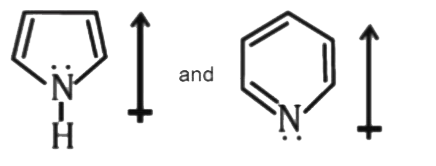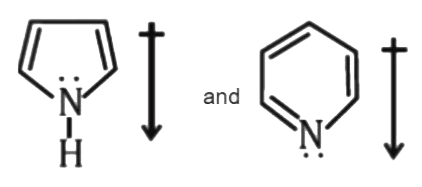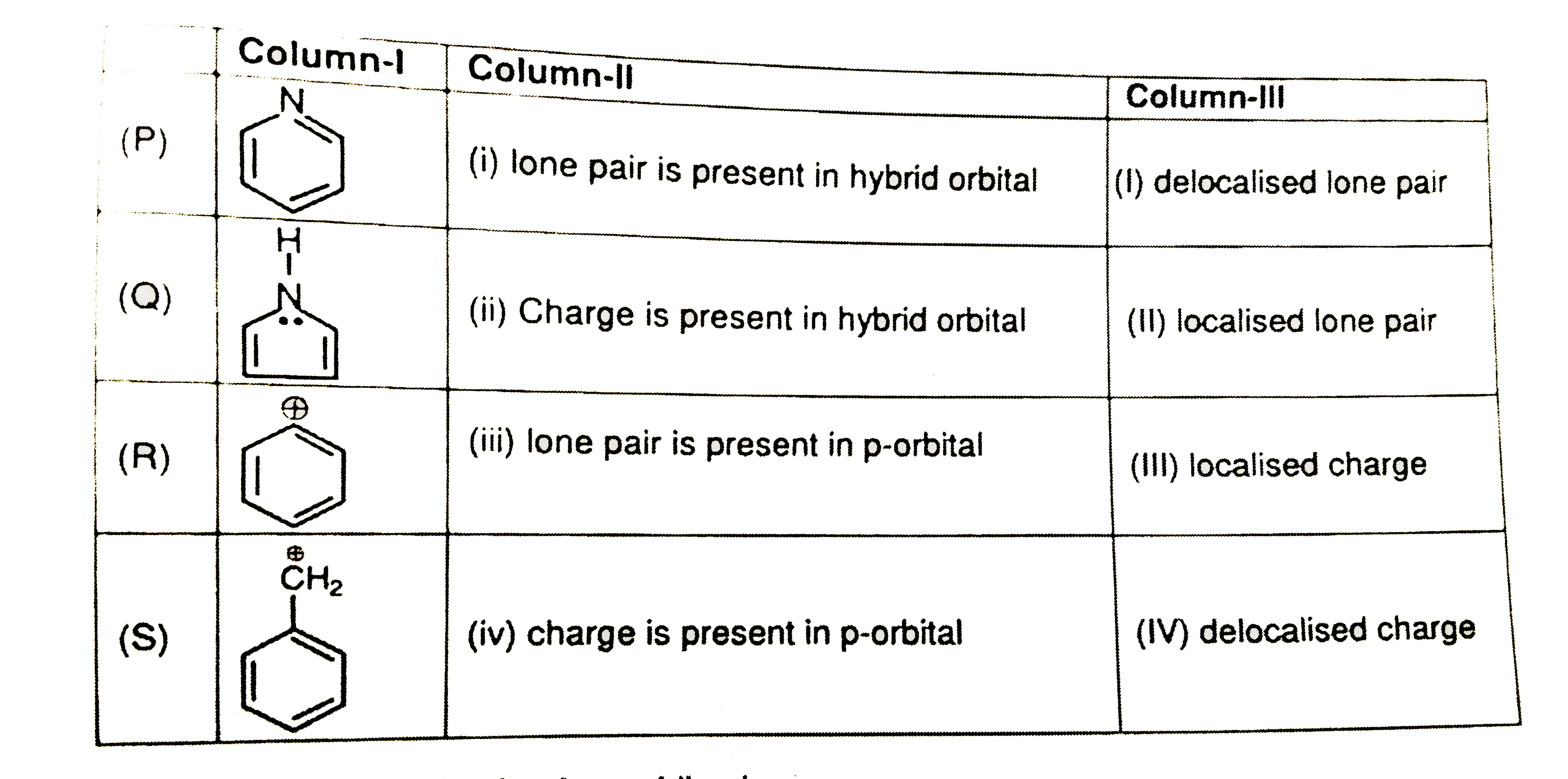The correct orientation of dipoles in pyrrole and pyridine is




The correct Answer is:A
To determine the correct orientation of dipoles in pyrrole and pyridine, we need to analyze the resonance structures of both compounds and the resulting charge distributions. Here’s a step-by-step breakdown of the solution:
Step 1: Understand the Structures of Pyrrole and Pyridine
- Pyrrole is a five-membered aromatic ring containing one nitrogen atom.
- Pyridine is a six-membered aromatic ring also containing one nitrogen atom.
Step 2: Draw the Resonance Structures of Pyrrole
1. Start by drawing the basic structure of pyrrole:
- It has a nitrogen atom in the ring with two hydrogens attached to it.
2. Identify the lone pair on the nitrogen atom:
- The lone pair can participate in resonance by forming a double bond with one of the carbons in the ring.
3. Shift the double bond:
- When the lone pair on nitrogen forms a double bond with a carbon, it creates a negative charge on another carbon in the ring.
4. Draw the resonance structures:
- Continue shifting the double bonds to show the movement of the negative charge around the ring.
Step 3: Determine the Charge Distribution in Pyrrole
- After analyzing the resonance structures, you will find that the nitrogen atom carries a partial positive charge (due to the loss of its lone pair) and the ring carries a partial negative charge.
- Therefore, the dipole moment in pyrrole points from the nitrogen (positive) to the ring (negative), which means the dipole is directed upwards.
Step 4: Draw the Resonance Structures of Pyridine
1. Draw the basic structure of pyridine:
- It has a nitrogen atom in the ring with one hydrogen attached.
2. Identify the double bonds in the ring:
- The nitrogen atom is part of the aromatic system but does not have a lone pair that can participate in resonance like in pyrrole.
3. Shift the double bonds:
- The double bond adjacent to the nitrogen can shift towards the nitrogen, creating a partial negative charge on the nitrogen and a partial positive charge on the adjacent carbon.
4. Draw the resonance structures:
- Show the movement of the double bonds and the resulting charge distribution.
Step 5: Determine the Charge Distribution in Pyridine
- In pyridine, the nitrogen atom carries a partial negative charge, while the ring has a partial positive charge.
- Thus, the dipole moment in pyridine points from the ring (positive) to the nitrogen (negative), which means the dipole is directed downwards.
Step 6: Conclusion
- From the analysis, we find:
- Pyrrole: Dipole moment points upwards (from nitrogen to the ring).
- Pyridine: Dipole moment points downwards (from the ring to nitrogen).
- Therefore, the correct orientation of dipoles is that in pyrrole the dipole points upwards, and in pyridine, it points downwards.
Final Answer
The correct option is A: Pyrrole has a dipole moment pointing upwards, and pyridine has a dipole moment pointing downwards.
---
- Pyrrole is a five-membered aromatic ring containing one nitrogen atom.
- Pyridine is a six-membered aromatic ring also containing one nitrogen atom.
1. Start by drawing the basic structure of pyrrole:
- It has a nitrogen atom in the ring with two hydrogens attached to it.
2. Identify the lone pair on the nitrogen atom:
- The lone pair can participate in resonance by forming a double bond with one of the carbons in the ring.
3. Shift the double bond:
- When the lone pair on nitrogen forms a double bond with a carbon, it creates a negative charge on another carbon in the ring.
4. Draw the resonance structures:
- Continue shifting the double bonds to show the movement of the negative charge around the ring.
- After analyzing the resonance structures, you will find that the nitrogen atom carries a partial positive charge (due to the loss of its lone pair) and the ring carries a partial negative charge.
- Therefore, the dipole moment in pyrrole points from the nitrogen (positive) to the ring (negative), which means the dipole is directed upwards.
1. Draw the basic structure of pyridine:
- It has a nitrogen atom in the ring with one hydrogen attached.
2. Identify the double bonds in the ring:
- The nitrogen atom is part of the aromatic system but does not have a lone pair that can participate in resonance like in pyrrole.
3. Shift the double bonds:
- The double bond adjacent to the nitrogen can shift towards the nitrogen, creating a partial negative charge on the nitrogen and a partial positive charge on the adjacent carbon.
4. Draw the resonance structures:
- Show the movement of the double bonds and the resulting charge distribution.
- In pyridine, the nitrogen atom carries a partial negative charge, while the ring has a partial positive charge.
- Thus, the dipole moment in pyridine points from the ring (positive) to the nitrogen (negative), which means the dipole is directed downwards.
- From the analysis, we find:
- Pyrrole: Dipole moment points upwards (from nitrogen to the ring).
- Pyridine: Dipole moment points downwards (from the ring to nitrogen).
- Therefore, the correct orientation of dipoles is that in pyrrole the dipole points upwards, and in pyridine, it points downwards.
The correct option is A: Pyrrole has a dipole moment pointing upwards, and pyridine has a dipole moment pointing downwards.
Similar Questions
The correct order of dipole moment is :
View SolutionThe correct order of dipole moment is :
View Solution
The only correct combination for pyrrole is
View SolutionCorrect order of dipole moment is
View SolutionThe correct order of the dipole moment is :
View SolutionHybridization of nitrogen atom in pyridine is

View Solution
The only correct combination for pyridine is -
View SolutionIn each situation of Column - I, two electric dipoles having dipole moments →p1and→p2 of same magnitude (that is,p1=p2) are placed on x-axis symmertrically about origin in different orientations as shown. In column - II certain inferences are drawn for these two dipoles. Then match the different orientations of dipoles in column - I with the corresponding results in column - II. [In column I the co-ordinates corresponding to the centres of dipoles and dipoles having the same dipole lenght]

View SolutionThe correct order of dipole moments of HX bond in the given compounds is :
View SolutionOrientation of orbitals is given by
View Solution
